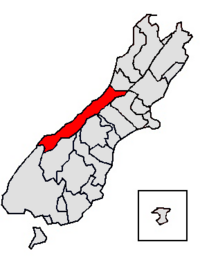Westland District facts for kids
Quick facts for kids
Westland District
|
|
|---|---|
|
Territorial authority district
|
|

Gillespie Beach, Westland
|
|
 |
|
| Country | New Zealand |
| Region | West Coast |
| Wards |
|
| Seat | Hokitika |
| Area | |
| • Total | 11,827.86 km2 (4,566.76 sq mi) |
| Population
(June 2023)
|
|
| • Total | 8,940 |
| • Density | 0.7558/km2 (1.9576/sq mi) |
| Time zone | UTC+12 (NZST) |
| • Summer (DST) | UTC+13 (NZDT) |
| Postcode(s) |
Map of postcodes
|
| Area code(s) | 03 |
The Westland District is a special area on the West Coast of New Zealand's South Island. It's like a local government area, managed by the Westland District Council. About 8,640 people live here.
Contents
A Look at Westland's History
Westland was once part of a bigger area called Canterbury Province. This area was managed from Christchurch, which is on the other side of the Southern Alps.
Gold Rush and New Beginnings
A huge gold rush brought many people to Westland. But traveling and communicating across the mountains was very hard. Because of this, Westland first became its own county. Then, it officially separated from Canterbury to form the Westland Province (1873–1876). This province also included parts of what is now the Grey District.
After 1876, the provinces were removed. A new Westland County was created with almost the same borders. Around this time, the number of people living in Westland started to drop. The easy-to-find gold ran out, and the land wasn't great for farming.
Modern Westland District
Later, local government changes happened. The areas around Greymouth became the Grey District. Westland stayed mostly the same, changing from a county to a district. It also included the town of Hokitika.
Recently, more people have started moving to Westland. They come for the lifestyle, enjoying the beautiful nature and quiet living.
Exploring Westland's Geography
The Westland District is a long, narrow strip of land. It stretches between the high peaks of the Southern Alps and the Tasman Sea.
Mountains, Forests, and Glaciers
Near the coast, you'll find farms and rainforests. These forests have many tall trees and get a lot of rain. This is because the Southern Alps push the moist air upwards, causing rain. The eastern part of Westland is very mountainous. Many small rivers flow down from these mountains.
A famous part of Westland is home to the Franz Josef and Fox glaciers. These are huge, slow-moving rivers of ice.
Borders and Rivers
In the north, the Taramakau River forms the border with the Grey District. This is the biggest river in Westland. The top of the Southern Alps marks the eastern border. A small southern border separates Westland from Fiordland. You cannot drive across this southern border.
Towns and Communities
Hokitika is the main town and the district's center. It's the only town in Westland with more than 1,000 people. About 2,892 people live in Hokitika. This is a big part of the district's total population.
Other communities in Westland include:
- Northern Ward:
- Southern Ward:
- Bruce Bay
- Fox Glacier
- Franz Josef / Waiau
- Haast
- Hannahs Clearing
- Hari Hari
- Jackson Bay
- Neils Beach
- Ōkārito
- Okuru
- Pukekura
- Te Taho
- Whataroa
Notes: bold means it's a settlement (a small town or village); normal text means it's a locality (a smaller place).
Westland's Population and People
Westland District covers a large area of about 11,827 square kilometers. It is the most spread-out district in New Zealand. This means it has the fewest people per square kilometer.
Who Lives in Westland?
In 2023, about 8,901 people lived in Westland District. This was a small increase from 2018. The average age of people in Westland is 47.3 years old. This is older than the national average for New Zealand.
- About 15.5% of people are under 15 years old.
- About 21.1% of people are 65 years or older.
Most people in Westland are of European background (87.2%). There are also people of Māori (16.5%), Pasifika (2.0%), and Asian (4.7%) backgrounds. Some people identify with more than one ethnicity.
Jobs and Income
Many people in Westland work full-time (55.3%). The average income in Westland is $29,600 per year. This is a bit lower than the national average for New Zealand.
Westland's Economy
Westland's economy has changed a lot over time.
From Gold to Tourism
In the early days, gold was very important. Many people came to Westland hoping to find gold. After the gold ran out, people who stayed started farming. Westland did not develop coal mining like other parts of the West Coast.
Today, tourism is a big part of Westland's economy. Many visitors come to see the amazing glaciers, like Franz Josef and Fox. Events like the Hokitika Wildfoods Festival also attract many people.
Images for kids
See also
 In Spanish: Distrito de Westland para niños
In Spanish: Distrito de Westland para niños



